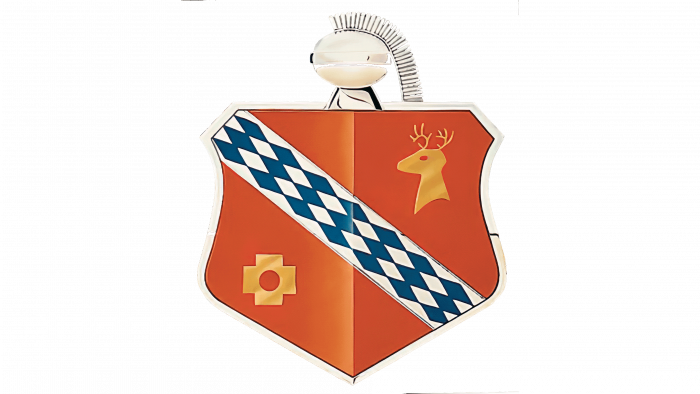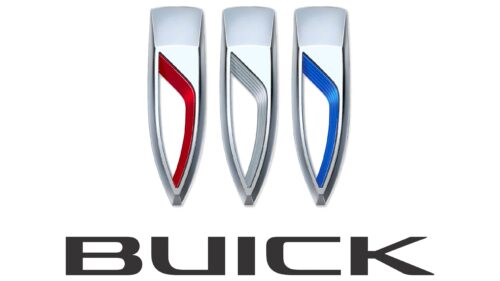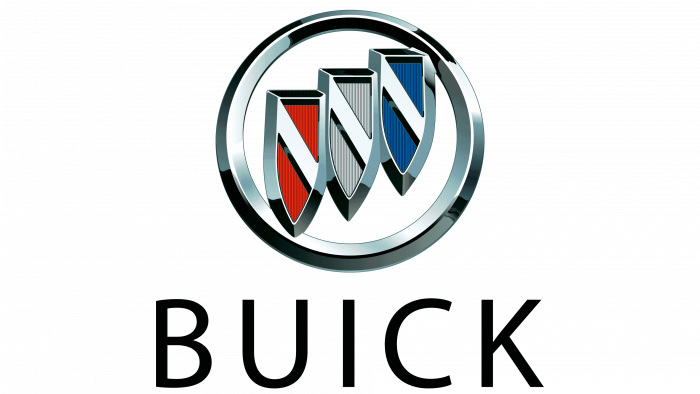The Buick logo gives customers confidence in the safety of the company’s vehicles. Reliability is formed by combining three components: speed, perfect assembly, and quality of parts. They are like a shield that prevents damage.
Buick: Brand overview
Meaning and History
The current logo keeps David Dunbar Buick’s memory, or rather, of his family coat of arms. The design was based on a short description of the heraldic shield: the Buick family’s family symbol. This information was mentioned in the British genealogical publication Burke’s Peerage, Baronetage & Knightage. By coincidence, the book fell into the hands of Ralph Pew, who was studying the corporate identity of General Motors (a holding company that Buick entered in 1908).
In addition to shield emblems, the brand had badges with car decorations. Many of them were manufactured by Ternstedt Manufacturing Co. Despite this, the modern design is based on the three-shield symbol that appeared in 1959.
What is Buick?
It is one of the divisions of General Motors, the largest US auto corporation. Cars that are produced under the Buick brand are available in the North American market and overseas.
1903 – 1905
The first logo looked like an image of the globe with continents, oceans, parallels, and meridians. The center of the map was the inscription “KNOWN ALL OVER THE WORLD,” and at the bottom – THE BUICK MOTOR COMPANY FLINT MICH. U.S.A. “. Uncle Sam, the national symbol of the United States, walked across the planet. He rolled behind him a small cart with a car.
1905 – 1911
The Buick badge first appeared on cars in 1905. It was a brass badge that adorned the Buick Model C radiator grill. The word was inside a dark circle in a ring bearing the slogan “THE CAR OF QUALITY.”
1911 – 1913
In 1911, the company began using a monogrammed logo: a large, stylized B with capitals U, I, C, and K.
1913 – 1930
Two years later, the designers used a handwritten underlined font for the word “Buick.” They made the lettering white, rotated it 45 degrees, and positioned it over a blue square with a wide light border.
1930 – 1937
In the early 1930s, a new brand name appeared on the radiator grilles: the brand name was written diagonally and supplemented with the number “8.” Both parts were red. Figure eight stood for the engine’s eight-cylinder power.
1937 – 1939
When Ralph Pew found a Buick family coat of arms edition, the company used that symbol instead of a logo. The book had no illustrations, so the designers relied only on short text. They recreated a red shield crossed by a diagonal checkered line. In one corner was a gold deer head, and in the other, across with a round hole in the middle.
1939 – 1942
In 1939, a new interpretation of the emblem appeared: the shield was extended vertically and turned pink-red.
1942 – 1947
The designers changed the shield’s shape, supplemented it with classic heraldic patterns, and placed it inside a large black circle. This badge was used only in 1942 when the company began producing military equipment.
1947 – 1949
The new interpretation of the Buick coat of arms contained a shield over which the engine element was located. The decorative patterns and circles have been removed.
1949 – 1959
1949, a shiny frame with a metallic sheen appeared around the shield. It was added to make the logo match the style of the cars.
1959 – 1997
Buick revolutionized identity when it introduced an emblem with three overlaid shields: one blue, the second silver-gray, and the third red. They were inside a wide ring and represented three brands: Electra, Invicta, and LeSabre.
1975 – 1976
The Skyhawk cars had their badge: a black hawk inside the ring. This design proved successful, so it was switched to all car lines in 1976.
1976 – 1990
In the second version, a golden hawk landed on the word “BUICK.”
1990 – 2002
When the company retired the red-tailed hawk Happy (Buick’s mascot featured in the commercial), it noticed a three-shield emblem. The designers removed the crest, repainted the checkered diagonal white, and placed the blue word “BUICK” under the ring. In addition to the main 2D version, there was a 3D version with a darker palette.
2002 – 2015
The shields’ insides have turned white, and the outlines and diagonal lines have been repainted in chromed metal.
2015 – 2023
On the right side of the logo, there is a minimalistic black inscription “BUICK.” The previous colors returned to the shields: red, silver, and blue. This badge first adorned LaCrosse vehicles in 2017.
2023 – today
On March 16, 2022, General Motors applied to register a new trademark with the USPTO. It was named “Three stylized shields,” which fully describes its structure. Like the old one, the new Buick logo contains three heraldic shields shaped like elongated triangles. However, now they are not glued together and are not arranged diagonally but have small gaps and are aligned in a single row. The surrounding ring has disappeared.
Design manager Steve McCabe admitted that removing the ring and aligning the shields was not initially planned. It happened accidentally after GM CEO Mark Reuss saw a car sketch with several stripes in place of the Buick badge. Such sketches are usually made with rough lines without detailing; the traditional logo is added later. However, Mark Reuss liked the simplified version. The modern design was meant to show the brand’s evolution. After all, Buick has a far-reaching goal – to become an electric car manufacturer. Perhaps that is why the even stripes inside the shields have been replaced with more dynamic, curved lines. They embody energy, movement, and innovation.
A colored version of the logo was published on the company’s website, according to which the left stripe is red, the middle one is gray, and the right one is blue. All three shields have a silver gradient, while the inscription is completely gray, without a shade transition. Even after that, in 2023, there were rumors that Buick would use the black-and-white emblem as the primary one, as General Motors patented it. The brand’s name is written at the bottom in an asymmetrical font created specifically for the automotive brand.
Buick: Interesting Facts
Buick, part of General Motors (GM), is one of the oldest and most prestigious car brands, known for its luxury and innovative designs.
- Early Days: Buick started in 1899, making it the oldest American car brand. It began with David Dunbar Buick’s company and quickly became a key player, laying the groundwork for GM.
- Engine Innovation: Buick led the way with the valve-in-head engine, now called the overhead valve engine, around the early 20th century. This major leap forward made engines more efficient and powerful.
- Building GM: Buick’s success helped William C. Durant create General Motors in 1908, uniting various car brands under one big family.
- Luxury and Speed: Buick is known for its luxury but also dabbles in speed. Models like the 1980s Grand National and GNX were turbocharged speedsters.
- Popularity in China: Buick has been big in China since the 1920s and now sells more cars there than in the U.S., making it a truly global brand.
- Unique Market Spot: Buick finds its niche between the every day and the upscale, offering luxury without the hefty price tag and appealing to a broad audience.
- Safety and Comfort First: Innovations weren’t just about speed or luxury; Buick introduced the first car turn signals in 1939 and quickly adopted power steering and brakes, focusing on a safer, smoother ride.
- Going Green: Buick has recently been working on being more eco-friendly, offering mild hybrid tech in some cars to reduce fuel use without losing power.
- Reliable Rides: Buick is often praised for reliability, consistently scoring high in studies for its durable and long-lasting vehicles.
- The Riviera: In 1963, the Riviera hit the scene with its eye-catching design and performance, becoming an iconic model highlighting Buick’s luxury and innovation blend.
Buick’s long-standing tradition of blending innovation with luxury and reliability has cemented its place as a distinguished and beloved car brand in the auto world.
Font and Colors
The modern brand symbol no longer resembles the David Dunbar Buick family crest. After many redesigns, no deer heads, crosses, or chess patterns remained on the shields. It is now simply a recognizable emblem associated with the Buick brand.
The designers used the Avenir font for the wordmark, a geometric sans-serif developed in 1988. The color scheme contains several shades of red, blue, and silver, complemented by white and black, accentuating the gradient and enhancing the 3D effect.
FAQ
Why did Buick change their emblem?
The brand has changed its logo to align with its vision of an electric future. By 2030, it plans to offer only electric vehicles (EVs). This significant change in the lineup required a new, modern logo to show the new direction.
This change began a new family of electric vehicles called the Buick Electra. The rebrand is designed to attract a forward-thinking customer base and signal a new era for the brand. Based on a partial sketch, the new logo connects the brand’s rich history with its future goals.
What is the three-shield logo?
The three-shield logo is the key symbol of the brand. Each shield represents one of the company’s early models: LeSabre, Invicta, and Electra. The shields are arranged diagonally, each with a red, white, and blue color scheme.
Over the years, the three-shield logos have been updated to remain modern and relevant. Despite the changes, the main elements have remained the same, maintaining the original meaning. The shields represent the brand’s rich history, technological advancements, and commitment to producing reliable and innovative vehicles.
What does the Buick logo mean?
The logo with three shields echoes the family coat of arms of David Dunbar Buick, the company’s founder. This emblem honors his legacy. The modern design has become simplified over time, losing some of its original elements, but it remains significant.
Each shield symbolizes the brand’s respect for its founder and roots. The shields are arranged diagonally and have a red, white, and blue color scheme. These colors symbolize the brand’s American heritage and long-standing presence in the automotive industry. Simplifying the design has made it more modern and relevant to today’s audience.
Is Buick a Chevy?
No, these are two brands owned by General Motors (GM). Each brand has its personality, product range, and target market.
Buick focuses on luxury and comfort. The brand aims to attract customers looking for premium cars with advanced features and elegant design. The lineup includes sedans, SUVs, and crossovers that offer a smooth and refined driving experience.
Chevy offers a wider selection of vehicles, including trucks, SUVs, sedans, and electric vehicles. The brand targets a wide audience, from families to performance enthusiasts, and emphasizes practicality, reliability, and affordability.
Both brands operate independently and compete in the North American market.
Is Buick a luxury brand?
It is considered a mid-tier luxury brand within General Motors. It offers premium features and great comfort but is less luxurious than Cadillac, GM’s leading luxury brand.
The brand’s vehicles provide an upscale experience with refined interiors, advanced technology, and smooth ride quality. The lineup includes sedans, SUVs, and crossovers for customers who want a comfortable and stylish ride without the high cost of ultra-luxury brands. This approach attracts customers who seek luxury without paying top prices, setting the brand apart in the competitive automotive market.
Where is Buick made?
The company has production facilities in the USA, Germany, South Korea, China, and Canada.
The brand produces cars in Michigan and Kansas in the US, which are key to the North American market. Germany focuses on engineering and high-quality production. South Korea produces many compact and mid-size models. China can meet local and export needs. Canada has a long history of producing various models of this brand.
These capabilities help the brand meet global demand and maintain quality. This international network supports the brand’s competitiveness and ability to respond to different markets.























